
Monte Bolca is a lagerstätte near Verona, Italy that was one of the first fossil sites with high quality preservation known to Europeans, and is still an important source of fossils from the Eocene.

Weevers are nine extant species of fishes of family Trachinidae, order Trachiniformes, part of the Percomorpha clade. They are long, mainly brown in color, and have venomous spines on their first dorsal fin and gills. During the day, weevers bury themselves in sand, just showing their eyes, and snatch prey as it comes past, which consists of shrimp and small fish.

Handfish are any anglerfish within the family Brachionichthyidae, a group which comprises five genera and 14 extant species. These benthic marine fish are unusual in the way they propel themselves by walking on the sea floor rather than swimming.

Urolophus is a genus of round rays mostly native to the western Pacific Ocean and the Indian Ocean, though one species occurs in the Pacific waters of the Mexican coast. Müller and Henle erected Urolophus in an 1837 issue of Bericht Akademie der Wissenschaften zu Berlin. The name is derived from the Greek oura, meaning "tail", and lophos, meaning "crest". In Urolophus, the outer rims of the nostrils are not enlarged into lobes, but may form a small knob at the back.

Amphistium paradoxum, the only species classified under the genus Amphistium, is a fossil fish which has been identified as a Paleogene relative of the flatfish, and as a transitional fossil. In a typical modern flatfish, the head is asymmetric with both eyes on one side of the head. In Amphistium, the transition from the typical symmetric head of a vertebrate is incomplete, with one eye placed near the top of the head.
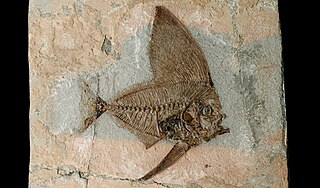
Exellia is a genus of extinct spadefish that lived in the Tethys Ocean during the early Paleogene. The adult form is shaped akin to a large spadefish or a short dolphinfish, with very large pelvic fins, and a long dorsal fin starting from in front of the eyes to near the base of the caudal peduncle. The juvenile form resembles a juvenile drumfish, with the dorsal fin forming a long crest on top of the head.

Archaeophis is an extinct genus of snake from the Eocene of Monte Bolca.

Spinacanthus cuneiformis is an extinct prehistoric tetraodontid bony fish that lived from the Lutetian epoch of Eocene Monte Bolca.
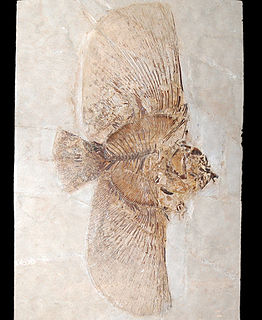
Eoplatax is an extinct genus of prehistoric spadefish that lived during the Lutetian of Monte Bolca. They are closely allied to the extant genus, Platax, more commonly known as "batfish."
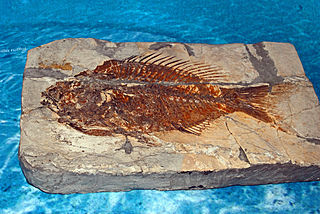
Sparnodus is an extinct genus of prehistoric perciform fish in the family Sparidae. Species of this genus were nektonic carnivore. These fishes lived in the Cenozoic Era, in Oligocene and Paleocene.
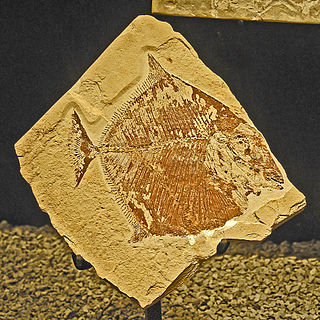
Palaeobalistum is an extinct genus of prehistoric ray-finned fish which ranged from the Cretaceous to Eocene periods.

Protobalistum imperiale is an extinct prehistoric tetraodontid bony fish that lived from the Lutetian epoch of Eocene Monte Bolca.
Pietschellus is an extinct genus of enigmatic bony fish which existed in northern Italy during the early Eocene epoch. It is known from a single well-preserved nearly complete specimen recovered from the Monte Postale site of the Monte Bolca locality. It was first named by Alexandre F. Bannikov and Giorgio Carnevale in 2011 and the type species is Pietschellus aenigmaticus.

Spinacanthidae is an extinct prehistoric family of tetraodontid bony fish that lived from the Lutetian epoch of Eocene Monte Bolca.

Rhizostomatidae is a family of cnidarians in the class Scyphozoa.

Pristigenys is a genus of marine ray-finned fish in the family Priacanthidae. It contains five extant species and one extinct species, P. substriata, which is known from fossils found in the Eocene of Monte Bolca, Italy.
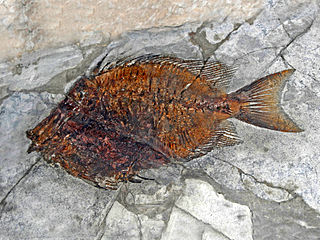
Naseus is an extinct genus of surgeonfishes from the Lutetian-aged Monte Bolca Lagerstätte.

Lophius brachysomus is an extinct species of anglerfish in the family Lophiidae. It was described by Louis Agassiz in 1835 from the Monte Bolca locality. It became extinct during the middle Eocene.

Siphonostomites hesionoides is a species of polychaete annelid known only from subtidal lagoon deposits from the Early Eocene of Monte Bolca, Verona, Italy.
Arechia is an extinct genus of stingaree from the Eocene epoch. It is the oldest known stingaree genus, though molecular data suggests they diverged from Butterfly rays about 75 million years ago or from Deepwater stingrays around the time of the K-Pg transition. The type species, A. arambourgi, is known from isolated teeth found in the Ypresian deposits of Ouled Abdoun, Morocco. It is named for Camille Arambourg, who originally ascribed these teeth to Raja praealba in 1952. Henri Cappetta revised the species in 1983, erecting this genus for those Arambourg called males in this genus and placed the ones he called females in Merabatis. The second species, A. crassicaudata is from the Ypresian-age Bolca Lagerstätte of Italy and is known from several articulated individuals. This species was described in 1818 and was placed in various genera until finally being attributed to this one in 2020. The inferred environment of the Monte Postale site where this species is found matches with the typical warm, shallow environment of extant representatives of this family.















